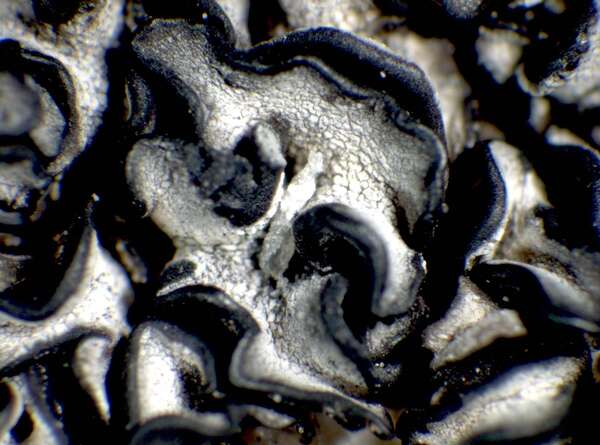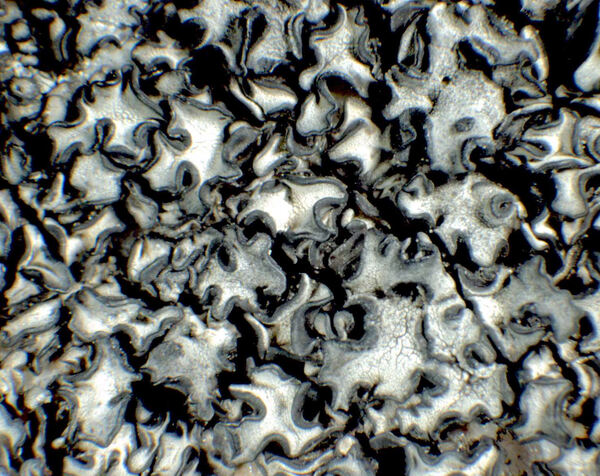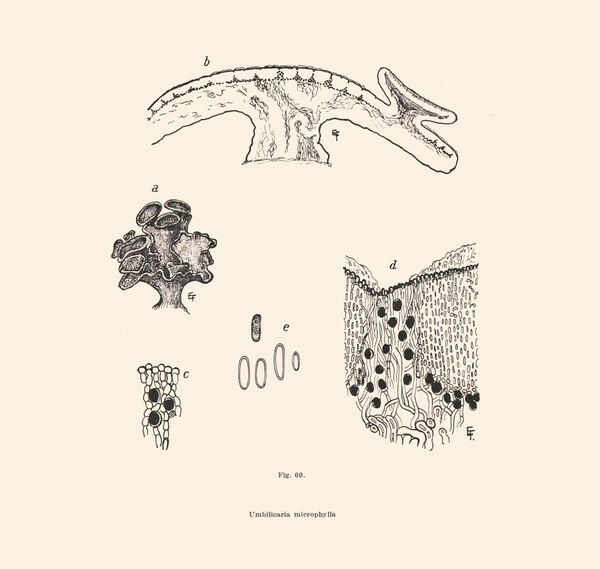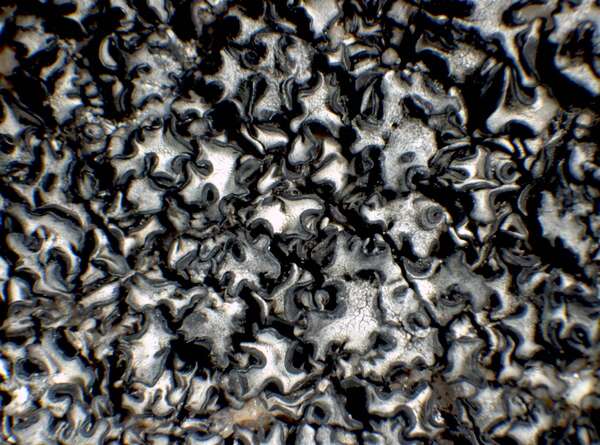Umbilicaria microphylla (Laurer) A. Massal.
Ric. Auton. Lich. Crost.: 62, 1852. Basionym: Umbilicaria atropruinosa var. microphylla Laurer in Sturm - Deutschl. Fl., 2, 24: 13, 1832.
Synonyms: Agyrophora microphylla (Laurer) Llano; Gyrophora anthracina var. microphylla (Laurer) Rabenh.; Gyrophora microphylla (Laurer) Arnold
Description: Thallus foliose-umbilicate, heteromerous, dorsiventral, small, to 0.5 cm in diam., 0.15-0.2 mm thick, monophyllous, but many individual thalli growing together, giving the appearance of a polyphyllous thallus, with ascending and undulating margins and black, glossy, tumid edges, attached by a black, thick central holdfast. Upper surface mouse-grey, dull, rimose, paler toward the center. Lower surface dark brown to brown-black, smooth, but often scabrous around the umbilicus. Upper cortex palisade-plectenchymatous, 10-20 µm thick; algal layer continuous; medulla white, both loose and plectenchymatous, and compact and scleroplectenchymatous, 40-70 µm thick; lower cortex paraplectenchymatous, brown, ca 20 µm thick. Apothecia very rare, black, leiodisc. Photobiont chlorococcoid. Spot tests: medulla K-, C+ red, KC+ red, P-. Chemistry: medulla with gyrophoric acid.
Growth form: Foliose, umbilicate
Substrata: rocks
Photobiont: green algae other than Trentepohlia
Reproductive strategy: mainly sexual
Commonnes-rarity: (info)
Alpine belt: rare
Subalpine belt: very rare
Montane belt: absent
Dry submediterranean belt: absent
Humid submediterranean belt: absent
Padanian area: absent
pH of the substrata:
1 2 3 4 5
Solar irradiation:
1 2 3 4 5
Aridity:
1 2 3 4 5
Eutrophication:
1 2 3 4 5
Poleotolerance:
0 1 2 3
Altitudinal distribution:
1 2 3 4 5 6
Rarity
absent
extremely rare
very rare
rare
rather rare
rather common
common
very common
extremely common
Loading data...
Occurrence data
Predictive map

P.L. Nimis; Owner: Department of Life Sciences, University of Trieste
Herbarium: TSB (34460)
2002/01/15

P.L. Nimis; Owner: Department of Life Sciences, University of Trieste
Herbarium: TSB (34460)
2002/01/15
Growth form: Foliose, umbilicate
Substrata: rocks
Photobiont: green algae other than Trentepohlia
Reproductive strategy: mainly sexual
Commonnes-rarity: (info)
Alpine belt: rare
Subalpine belt: very rare
Montane belt: absent
Dry submediterranean belt: absent
Humid submediterranean belt: absent
Padanian area: absent
pH of the substrata:
| 1 | 2 | 3 | 4 | 5 |
Solar irradiation:
| 1 | 2 | 3 | 4 | 5 |
Aridity:
| 1 | 2 | 3 | 4 | 5 |
Eutrophication:
| 1 | 2 | 3 | 4 | 5 |
Poleotolerance:
| 0 | 1 | 2 | 3 |
Altitudinal distribution:
| 1 | 2 | 3 | 4 | 5 | 6 |
Rarity
absent
extremely rare
very rare
rare
rather rare
rather common
common
very common
extremely common
Loading data...
Occurrence data
Predictive map

P.L. Nimis; Owner: Department of Life Sciences, University of Trieste
Herbarium: TSB (34460)
2002/01/15










